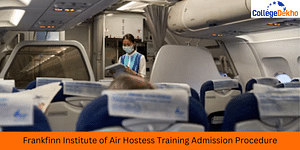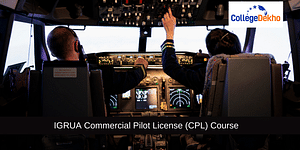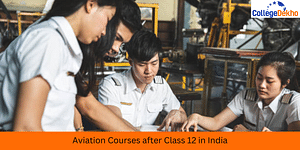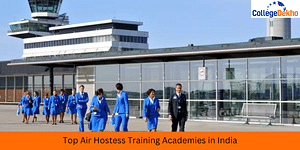Pilot Training
Students who complete pilot training have the knowledge and abilities necessary to soar over the skies. Navigation, meteorology, aerodynamics, and aircraft systems are among the topics covered in a normal pilot education. The requirements for enrollment in the Commercial Pilot Training course vary depending on whether you hold a Student Pilot Licence, Commercial Pilot Licence, or Private Pilot Licence.
About Pilot Training
Pilot training course is the training given to students to become proficient in aircraft operations. This training program is to make students understand the practical and theoretical aspects of aircraft. Students who are in love with the sky and see it to be their limit must pursue this course to come a step closer to their dreams. The pilot training course can be pursued at different course levels i.e. diploma, certificate and undergraduate.
Candidates who intend to apply for this training course must fulfil the basic eligibility criteria. They have to qualify for individual entrance and aptitude tests. The admission criteria for the pilot training course are based on the written and medical test followed by meeting a logged flying time. The pilot training syllabus and subjects revolve around aspects like flight physiology, flight instruments, navigation and others. Students can pursue this training course from different pilot training colleges in India including Indira Gandhi Institute Of Aeronautics (IGIA), Flytech Aviation Academy, Rajiv Gandhi University and various others. The fees for this training course range between INR 15,00,000 to 20,00,000. Post-completion of the pilot training course, students will be able to work as commercial pilots, jet Pilots, private pilots, flight instructors and other job roles with an average salary of INR 5,00,000 to 8,00,000.
Table of Contents
- About Pilot Training
- Pilot Training Course Highlights
- Pilot Training Course Eligibility Criteria
- Why Choose a Pilot Training Course?
- Types of Pilot Training Courses
- How to become a Pilot after 12th Class?
- Pilot Training Courses in India
- Pilot Training License Courses
- Pilot Training Licence Required
- Pilot Training v/s Aeronautical Engineering
- Pilot Training Admission Process
- Pilot Training Entrance Exam
- Pilot Training Colleges in India
- Study Pilot Training Abroad
- Pilot Training Colleges Abroad
- Pilot Training Fees
- Required Skill Set for Pilot Training
- Pilot Training Course Curriculum
- Pilot Training Syllabus
- Pilot Training Scope in India
- Pilot Training Salary
- Pilot Training Career Options
- Pilot Allowances and Perks
- Pilot Training Recruiters
- FAQs about Pilot Training
Pilot Training Course Highlights
The aviation profession is expanding and booming in today's times as the requirement for airways has been increasing. Candidates who are planning to pursue Pilot Training in India should go through the course highlights given below and check the important details like eligibility, colleges, scope, fees, etc.
| Particular | Details |
|---|---|
| Course Name | Pilot Training |
| Industry | Aviation Industry |
| Entrance Exam | AME CET, AFCAT, IGRUA |
| Licences | Student Pilot License, Private Pilot License, Commercial Pilot License |
| Eligiblity |
|
| Age Limit | Minimum age should be 16 year |
| Physical Fintess |
|
| Colleges in India |
|
| Colleges in Abroad |
|
| Course Fees | Rs. 15,00,000 LPA to Rs. 20,00,000 LPA |
| Salary | Rs.5,00,000 LPA to Rs. 8,00,000 LPA |
| Career Options | Commerical Pilot, Air Force India Pilot, Private Pilot, Jet Pilot, Experimental Pilot, Flight Insturctuer |
| Top Recruiters | Air India, Air India Charters Ltd, Air Costa, IndiGo, Air Asia, Spice Jet, |
Also read: Aviation Colleges in India
Pilot Training Course Eligibility Criteria
The eligibility criteria for pilot training course will differ based on the type of license and course. Students who want to pursue this training must fulfil the basic eligibility requirements. Check out the course-wise eligibility requirements below.
UG Course Eligibility Criteria
To pursue pilot training course at the UG level students must meet the basic eligibility criteria as prescribed by the exam authority. Check the pointers below:
- Students must have passed class 12th in the science stream scoring a minimum of 50% marks.
- They are required to have Mathematics and Physics as compulsory subjects.
Certificate Course Eligibility Criteria
Different certificate pilot training course will have varied eligibility criteria as mentioned below:
Student Pilot License (SPL)
Refer to the eligibility requirement for SPL below:
- Students must have minimum qualification i.e. class 10th passed.
- They are required to be 16 years or older than that for pursuing SPL.
- Students for this license have to appear in the oral test and a pilot aptitude test.
Private Pilot License (PPL)
Check out the eligibility criteria for PPL below:
- For PPL students must be of minimum 17 years of age.
- They must have passed their class 10th.
- Students are also required to qualify for the medical fitness exam.
Commercial Pilot Licence (CPL)
Candidates looking to gain a Commercial Pilot Licence through a pilot training course must meet the basic eligibility criteria as mentioned below:
- There is an age criterion to apply for CPL. The minimum age for this license is 17 years while the maximum age is 60-65 years.
- Candidates must have passed the class 12th with Physics, Chemistry and Mathematics as compulsory subjects.
- The minimum aggregate score in class 12th should not be less than 50%.
- They are also required to have qualified at least 2 medical tests as per DGCA.
Diploma Course Eligibility Criteria
Check out the eligibility criteria for different diploma pilot training course below:
Diploma in Airfare & Ticketing Management
Students must have classes 10th and 12th from a recognised board to pursue a Diploma in Airfare & Ticketing Management course.
Diploma in Ground Staff & Cabin Crew Training
Find the basic eligibility requirements for the diploma pilot training course below:
- For ground staff training, candidates must have passed their class 12th scoring at least a minimum of 40-50% in the relevant stream.
- To pursue cabin crew training, students are required to be between the ages of 17-25 years having good physical health. They must also have passed class 12th.
Why Choose a Pilot Training Course?
Pursuing a pilot training course solely depends on the interest of the student. However, determining this firm decision to dive into air navigation, aircraft systems and more related concepts in this training course requires considering several pointers. Some of the apt ones are mentioned below:
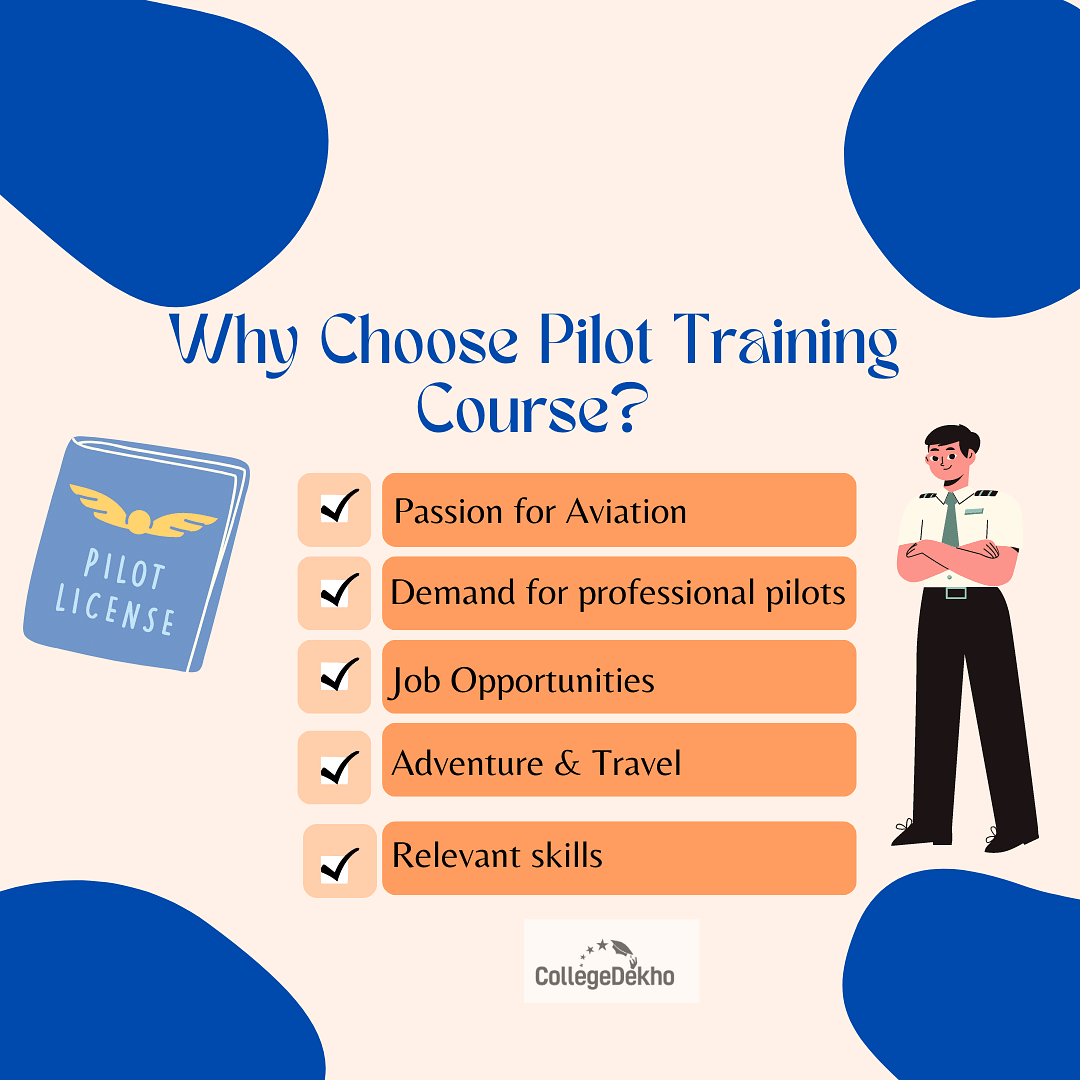
- Passion for Aviation
If the student has an interest in and passion for aviation then they can choose a pilot training course to come closer to the skies. Among various other career opportunities in aviation, the pilot is one of the most popular choices.
- Demand for professional pilots
As flight travel has become affordable, the growth and demand in the aviation industry have been rocketing ever since. This has increased the demand for professional pilots, so students thinking of making a career in this field must go for it.
- Job Opportunities
The job opportunities across the aviation industry are ample. After completing the pilot training course, individuals will be able to work in private aviation, commercial airline piloting, cargo transportation and others.
- Adventure & Travel
A pilot career can be a thrilling adventure ride as it includes travelling across the world. It can be a completely different lifestyle for someone adventurous about travelling.
- Relevant skills
Acquiring skills relevant to the discipline is very significant and through this pilot training course, students will get trained to become pilots along with gaining multiple skills. From behavioural skills to technical skills, students will acquire all the skills required.
Types of Pilot Training Courses
The pilot training course can be pursued at UG, certificate and diploma levels. It is not provided at the postgraduate level. Students have to pursue this training course to gain different licenses such as Commercial Pilot Licenses, Private Pilot Licenses, Integrated Commercial Pilot Licenses and more. Check out the different types of courses available below:
UG Courses
Some of the popular training courses at the UG level are mentioned below:
| BSc Aviation | BBA in Airport Management |
|---|---|
| BA Pilot Training | BSc in Airline and Airport Management |
| BSc Pilot Training | - |
Certificate Courses
This training course is also offered as a certificate level to gain different pilot certificates, check some of them below:
| Commercial Pilot Training | Private Pilot Training |
|---|---|
| Aspirant Pilot Program | Integrated Commercial Pilot License |
Diploma Courses
Some of the highly anticipated pilot training courses at the diploma level are given below:
| Diploma in Airport Management | Diploma in Aviation Hospitality |
|---|---|
| Diploma in Ground Staff and Cabin Crew Training | Diploma in Airfare & Ticketing Management |
How to become a Pilot after 12th Class?
Candidates can become a pilot in India after 12th class. For that, the candidate must secure a bachelor's degree as many of the recruiters demand a degree in aviation. Furthermore, the candidate should get experience in the field of aviation and get a license to earn a handsome salary in India or abroad.
Step 1: Secure a bachelor's degree
A bachelor's degree in any topic is required for an airline pilot, although a high school diploma or equivalent is normally required for a commercial pilot. Some flying schools are part of 2-4 year colleges/universities that offer the appropriate aviation or aeronautics degree and are FAA-approved (FAA).
Apply for Pilot Courses Following the 12th
After 10+2, another option for becoming a pilot is to enroll in a Commercial Pilot Training [CPL] programme. You will be needed to pass an admission exam, an interview, and a medical examination as determined by the institute.
Or
Apply through NDA Exams
In India, the prestigious NDA test isfor students who aspire to become pilots after completing their 12th grade. You must also undergo flying instruction after finishing the three-year course. Following that, you will be a permanent commission officer.
Other Important Information on How to Become a Pilot After 12th Grade:
- It is required to pass the DGCA's class 2 medical.
- Enroll at an aviation school.
- At least 200 hours of flight time
- Pass the examinations
- Obtain the CPL certificate.
Also read: Aviation Courses available after Class 12th
Step 2: Get the Flying Experience
If you want to be a pilot, you must complete a particular amount of flying training hours in order to obtain a license. Formal training will provide you with a basic education; but, if you want to obtain more in-depth information and experience, you may hire a personal teacher or even join the military for exposure. The number of training hours required is determined by the sort of pilot programme sought. For example, a commercial pilot's license requires 250 hours of flight experience, whereas an airline pilot requires 1,500 hours.
Step 3: Get a Pilot’s License
The first stage to get a pilot license is to complete the requisite number of flight hours, which is followed by a written evaluation demonstrating your flying talents and passing the physical test. The following is a list of important pilot licenses issued by the Civil Aviation Authority (CAA) in each country:
- Private Pilot Certificate (PPL)
- Commercial Pilot Certificate (CPL)
- Airline Transport Pilot Certificate (ATP)
- License for Multi-Crew Pilots (MPL)
- Certified Commercial Multi-Engine Land (CMEL) Flight Instructor (CFL)
Also read: AME CET Eligibility Criteria
Step 4: Additional training and tests
Many airlines need pilots to pass aptitude and psychological examinations as a condition of employment. Once assigned, pilots must complete additional weeks of training and flying time to get the feel of an expedition as co-pilots. Obtaining prior experience with a minor airline firm is usually advantageous in the long term if you aspire to eventually join a large airline.
Step 5: Advance Your Career as an Airline Pilot
The promotion from pilot to captain is entirely dependent on seniority and experience. To gain further flying ratings, you will need to pass additional FAA written and practical tests. You can keep learning and researching the industry's developments. The Aircraft Owners and Pilots Association (AOPA) and the International Federation of Airline Pilots Associations (IFALPA) provide enriching seminars and webcasts for mastery and progress.
Pilot Training Courses in India
There are several aviation degree and diploma courses in India that candidates can pursue after class 12th. The duration of this course vary. Following are some of the Aviation Courses that you can pick after Class 12.
Name of the Course |
Duration |
Eligibility/ Selection Criteria |
|---|---|---|
|
3 years |
Class 12 in any stream with a minimum of 50% marks |
|
|
BBA in Business Management |
3 years |
Minimum 50% marks in class 12 (any stream) |
|
Diploma in Airport Management |
1 year |
Students from all streams can apply after class 12 |
|
Commercial Pilot Training |
4 to 5 years (depending on flying hours) |
Minimum 45-50% marks in 12 with science stream (PCM) |
|
Aeronautical Engineering |
4 years |
Minimum 60% marks in 12 with science stream (PCM) |
|
Diploma in Ground Staff and Cabin Crew Training |
6 months to 1 year |
Students from all streams can apply after class 12 |
|
Diploma in Aviation Hospitality |
1 year |
Students from all streams can apply after class 12 |
|
3 years |
Class 12th in any stream with at least 50% aggregate score |
|
|
3 years |
At least 50% marks in Class 12th from any stream |
|
|
Diploma in Airfare & Ticketing Management |
6 months to 1 year |
Students from all streams can apply after class 12 |
|
B.Sc. Aviation |
3 years |
Minimum 50% marks in 12 with science stream (PCM) |
|
Aircraft Maintenance Engineering (AME) |
3 years (including 6 months training) |
Minimum 50% marks in 12 with science stream (PCM) |
Pilot Training License Courses
Pilot Training in India programmes are currently only available in an offline format because of the requirement of the physical aspect of the courses. . Pilot Training Courses, such as Student Pilot Licence Courses, Private Pilot License Courses, Commercial Pilot License Courses, and so on, are Certificate courses. In India, there are various options of crouse for Pilot Training.
- Commercial Pilot License (CPL) - This programme provides candidates with a solid foundation of theoretical and practical flying training, allowing them to meet the required standard for obtaining a relevant pilot license and pursuing a full-time career.
- Private Pilot License (PPL) - This license is designed for aviation enthusiasts or recreational flyers.
- CPL (ME / IR) - CPL plus Multi-Engine Type Rating plus Instrument Rating (IR) on a twin-engine aircraft. candidates will learn about flying in general, technical briefings, and dealing with simulated emergencies such as engine failures, among other things. For Indian candidates, this course is highly recommended.
- Instrument Rating (IR) – This refers to the qualifications that a candidate can pursue in order to fly under IFR (Instrument Flight Rules) and is applicable to both the CPL and the PPL.
- Instructor Rating – This course is for candidates who want to become flying instructors. The programme includes flight training as well as lessons on how to give lectures and briefings.
Pilot Training Licence Required
A candidate obtains an SPL (Student Pilot License), then a Private Pilot License (PPL), and lastly a Commercial Pilot License (CPL). Most institutions provide courses up to the CPL level, with the option of quitting out after obtaining a PPL. However, passing every barrier and following all of these requirements will only qualify you to fly as a co-pilot or first pilot. You must have an Airline Transport Pilot's License in order to fly as the chief captain.
Also read: IGRUA Eligibility Criteria
Pilot Training v/s Aeronautical Engineering
Candidates are often confused about pilot training and aeronautical engineering courses since both professions are from the same field. Therefore we have sketched the differences between the pilot training and aeronautical engineering courses in the table below.
| Criteria | Pilot Training | Aeronautical Engineering |
|---|---|---|
| Overview |
| Aeronautical Engineering is the study, design, and construction of flight-capable machinery, as well as the techniques for operating airplanes and aircraft. |
| Eligibility Criteria |
| Pass Class 10 and 12 with Physics, Chemistry, and Mathematics as compulsory subjects with a minimum of 70 to 75% marks. |
| Admission process |
|
|
| Entrance exams |
|
|
| Required skills |
|
|
| Career options |
|
|
Pilot Training Admission Process
The admission process of the pilot training institutes varies from institute to institute. Therefore we have sketched a basic admission process for the pilot training courses.
Step 1. Candidates will have to select a pilot training institute that they prefer
Step 2. Visit the official website of the institute
Step 3. They will have to appear for an entrance exam such as AFCAT, IGRUA, AME CET, etc.
Step 4. Fill out the application form of the entrance exam from the official website
Step 5. Pay the application fee as prescribed by the authorities
Step 6. Appear for the entrance examination and counselling
Step 7. Take admission into the selected college
Pilot Training Entrance Exam
Candidates who want to take admission to the Pilot Training colleges in India, need to clear the entrance examination. There are various Pilot Training Entrance Exams in India, that offer admission to aviation colleges. We have provided the list of aviation entrance exams below.
AFCAT
The Air Force Common Admission Test (AFCAT) is an entrance test held by the Indian Air Force to identify qualified and suitable applicants for a variety of positions in flying and ground duty [technical and non-technical]. The Indian Air Force (IAF) conducts the AFCAT test twice a year, and millions of students attempt to pass it in order to enter a reputed Air Force Academy and obtain a commission as an Indian Air Force Officer.
IGRUA
The Indira Gandhi Rashtriya Uran Akademi Entrance Exam, often known as the IGRUA Entrance Exam, is the entrance examination for admission to the Commercial Pilot Licence programme. Indira Gandhi Rashtriya Uran Akademi holds the IGRUA Entrance Exam 2022. Candidates who want to take admission to the Indira Gandhi Rashtriya Uran Akademi should pass this exam.
AME CET
The Aircraft Maintenance Engineering Common Entrance Test (AME CET) is a national-level common entrance test that provides admission to various courses throughout India. AME CET connects you with the best universities and colleges in India. AME CET advises its students and assists them in selecting the ideal job in the aviation industry. For students in the 10th and 12th grades, AME CET provides a variety of aviation courses including License, Engineering, Graduation, Diploma, and Certification.
Pilot Training Colleges in India
There are several colleges and universities in India that offers aviation training and certification courses, and degree programmes in India. Candidates can enroll in any of the colleges in India as per their liking and study. Go through the list of Pilot Training Colleges in India given below.
College Name |
Location |
|---|---|
|
Bombay Flying Club |
Maharashtra |
|
Uttar Pradesh |
|
|
National Flying Training Institute |
Maharashtra |
|
Madhya Pradesh Flying Club |
Madhya Pradesh |
|
Government Aviation Training Institute |
New Delhi, Bhubaneshwar and Odisha |
|
Ahmedabad Aviation and Aeronautics Limited |
Gujrat |
|
Puducherry Thakur College of Aviation |
Maharashtra |
|
Orient Flying School |
Karnataka |
|
Indigo Cadet Training Program |
In various state of India |
|
Maharashtra |
Study Pilot Training Abroad
Candidates can also opt for the option of studying a Pilot Training course in abroad. There are several top notch universities that offer this course with various specializations. Studying at an international university will accelerate your career rapidly, as abroad degrees holds is own prestige and offers better salary packages. Adding to that, the Pilot Training is given better in foreign in terms of technical aspects compared to India. Candidates will get many of career opportunities in India as well as anywhere in the world if they study pilot training from abroad.
Also read: Best Flying Schools in India
Pilot Training Colleges Abroad
Many international universities and colleges offer pilot training courses abroad. Candidates who can afford and pass the eligibility criteria can take admission to the Pilot Training colleges abroad. Check the list of top colleges that offers this course abroad given below.
College Name |
Location |
|---|---|
|
Embry Riddle Aeronautical University |
Florida, Daytona Beach, and Arizona, Prescott, United States. |
|
Purdue University |
United States |
|
Hallmark University |
United States |
|
University of North Dakota |
United States |
|
Spartan College of Aeronautics and Technology |
United States |
|
Ohio State University |
United States |
|
CTC Wings |
Europe |
|
San Jose State University |
United States |
|
Flight Safety Academy |
USA |
|
Singapore Flying College |
Singapore |
Pilot Training Fees
The Pilot Training courses fees are high compared to other programmes. Candidates who wish to make a career in the aviation industry should have a good budget to pursue education in the field. The total cost of the course varies from institution to college. The Pilot Training fees on average are between Rs. 15,00,000 to Rs. 20,00,000 LPA. It can also be more than this depending upon the college. Some of the Indian college's Pilot Training fees are
College/ Institution Name |
Fees (Approx) |
|---|---|
|
CAE-NFTI (National Flight Training Institute) Course Fee |
Rs. 42,00,000 + Taxes |
|
Indira Gandhi Rashtriya Uran Akademi Course Fee |
Rs. 50,00,000 |
|
Bombay Flying Club Course Fee |
Rs 90,000 to 1,20,000 Lakhs |
|
GATI (Government Aviation Training Institute) Course Fee |
Rs. 50,00,000 to Rs. 60,00,000 |
|
Madhya Pradesh Flying Club Course Fee |
Rs 90,000 to 1,20,000 Lakhs |
Required Skill Set for Pilot Training
To become a pilot, candidates should be medically and physically fit. Along with that, candidates should have certain qualities and skills to cope with the responsibilities of being a pilot. Aside from academic knowledge, students must have the following skills to be a good pilots:
- Must be physically fit and have good eyesight.
- Strong technical skills
- mentally alert and have emotional stability in times of crisis.
- Critical thinking and decision-making
- Situational and environmental awareness
- Good sense of teamwork
- leadership quality
- Good communication skills
- High-level flexibility
Also read: AME CET Syllabus
Pilot Training Course Curriculum
Pilot training is a two-year vocational programme that combines academic knowledge with practical experience to mold a proficient pilot. There are two forms of training in the curriculum: ground training and flight training.
The study of theoretical elements of flying is known as ground training. The most significant aspect of pilot training is flying training, which requires the candidate to log 200 hours of solo and tandem flight time in order to get a CPL (Commercial Pilot License).
The pilot training programme is intended to develop a disciplined and confident pilot capable of flying certain aircraft in either the private or commercial sectors.
Also read: AFCAT Syllabus
Pilot Training Syllabus
Pilot training is a highly skilled and professional education. Through the syllabus of this programme, candidates will be taught about the various aspects of pilot training like navigation, flight physiology, and flight instruments. Etc. The Pilot Training Syllabus consist of vocational subjects like,
- Aviation Meteorology
- Air regulation and navigation
- Basic Flight instruments
- Forces acting on the aeroplane
- Manoeuvring
- Flight Training Process
- Flight Physiology
- VOR Navigation
- Stability and Control
- Approach and Landing
- Go-around Factors
- Normal & Cross Wind take-off
- Solo Flight and Dual Flights
- Eight-on Pylons
- Power-off stalls
- Airframe
- Aeromedical Factors
Also read: IGRUA Syllabus
Pilot Training Scope in India
The aviation sector is thriving since air travel has grown less expensive and more convenient. As a result, there is a large job sector for pilot training specialists, which will provide many prospects for young people. "The Indian aviation industry will create 40 lakh employment in the next ten years," says former Civil Aviation Minister Praful Patel. Because of its complexity and energy, piloting is one of the highest-paying vocations. Aside from employment and pay, air navigation is many people's ideal career because of the work security and high esteem it provides. A pilot's work is quite exciting since it allows them to travel across the world and see different areas and cultures. Some of the reasoning why the aviation industry in India will boom are:
From Government to Private Ownership
Airports have transitioned from being a government institution to shared ownership; in the future, airlines are expected to become private enterprises, resulting in improved infrastructure and investment returns.
The Digital Security
The airline industry is fast moving toward "walk-through security" to boost functionality and minimize friction; one of the primary examples is the use of biometrics to automate verification processes.
High-end airport development
Airports have become more than just a transportation commodity; service providers are continually investing in airports, integrating diverse amenities, and delivering seamless services.
Also read: How to Get into Indian Air Force after 12th
Pilot Training Salary
A career in the aviation industry is very lucrative and offers high-end salary packages with various perks and allowances. As the pilot's profession is full of danger and life-threatening situations, hence their pay is greater than that of most other job profiles. A commercial pilot can earn between Rs. 1 and 5 lakhs per month, depending on the airline, but a private jet pilot might easily earn Rs. 50 lakhs per month. Candidates can check the Pilot salary in India depending upon their job profile below.
Job Profile |
Average Salary (Approx Estimate) |
|---|---|
|
Private Jet Pilot |
Rs.40,00,000 to Rs 50,00,000 LPA |
|
Co Pilot |
Rs.10,00,000 to Rs 12,00,000 LPA |
|
Flight Instructors |
Rs.32,00,000 to Rs 35,00,000 LPA |
|
Commercial Pilot |
Rs.12,00,000 to Rs 16,00,000 LPA |
|
Experimental Test Pilot |
Rs.8,00,000 to Rs 10,00,000 LPA |
|
Air Force Pilot |
Rs.12,00,000 to Rs 15,00,000 LPA |
|
Commuter Pilot |
Rs.16,00,000 to Rs 18,00,000 LPA |
Note- The above Pilot salary may vary as per the candidate's experience, skills, or company they are working in.
Also Read: Diploma courses after Class 12 Commerce
Pilot Training Career Options
The demand for pilots is increasing in India and abroad. Candidates will get various career options after completing the pilot training programme in India. Candidates might work for the following job descriptions after becoming qualified pilots.
Private Jet Pilot
A private Jet Pilot pilots a charter jet for private clients. They may convey business leaders from one city to another, professional sports teams, or celebrities to a movie set.
Co-Pilot
A co-pilot supports the pilot during flying. In most cases, freshmen are appointed as co-pilots. They aid the pilot in determining the route and speed, as well as during takeoff and landing. They also assume control of the airplane if the pilot fails to return to duty.
Commercial Pilot
They work for airlines, private enterprises, and people. This profile necessitates the possession of a pilot's license as well as a specified number of hours of flight experience.
Commuter Pilot
Commuting Pilots work on a contract basis, living outside of their customary country of residence and flying for the airline from their designated base.
Air Force Pilot
The Indian Air Force is one of the organizations that hire pilots. They are stationed at several outposts. They often fly fighter jets and aircraft in order to defend the Indian skies.
Experimentation Pilot
An Experimentation Pilots pilot freshly built planes that have never been flown before. They operate in three stages: plan, fly, and report.
Flight Instructors
Flight instructors coach student pilots on the ground and in the air, prepare lessons, and supervise pupils. Senior pilots are generally employed as flight instructors.
Also read: Aeronautical Engineering
Pilot Allowances and Perks
There is a great demand for pilots across the country both in private and government airlines. Pilots are paid really well as it is one of the high skill jobs that involves in-depth knowledge and training. The starting salary of a commercial pilot in India is Rs.8 lakh to Rs. 18 lakh. They also enjoy various other perks and benefits such as:
- Gratuity
- Contributory Provident fund
- Medical Facilities
- Concessional Air Fares/ Free Travel
- Medical Facilities
- Housing Allowance
Pilot Training Recruiters
Some of the top recruiters that hire qualified candidates who have done the pilot training course or certifications are
- Indigo
- Jet Airways
- Indian Airlines
- Air India
- Vistara
- Indian Air Force
- Spice Jet
- Air Asia
- Personal Charter Planes
Also read: Top Courses after 12th Commerce
We hope you find this post helpful and informative. For more details about various career stay tuned to CollegeDekho.
FAQs about Pilot Training
What are the best career options after completing the pilot training course?
Some best career options after completing the pilot training course include job profiles such as Chief Pilot, Agricultural Pilot, Co-Pilot, Experimental Test Pilot, Flying Instructor, and more. Applicants may begin their training early, and in certain cases, their Private Pilot Licence may even allow them to co-pilot light cargo aircraft. In addition, there are provisions for housing, health, and gratuities. Put simply, there are several extra benefits associated with choosing to work in the aviation industry.
What is the pilot training course fees in India?
The pilot training course fees in India may range from INR 1 to 40 lakhs depending on factors such as the type of programme, the flight school or training institution and its location, the type of aircraft used for training, etc. While the pilot training certificate may cost anywhere from INR 20 to 40 lakhs, the CPL Ground School Training may cost from INR 1 to 3 lakhs.
What are the benefits of pursuing a pilot training course?
Several benefits of pursuing a pilot training course are available to students as it improves their professional careers, lifestyle, and personal lives. Pilots often get to travel, interact with people from different cultures, and experience the exhilaration of flying. If you enjoy travelling to new countries and earning hefty salary packages, becoming a pilot may provide you with a unique lifestyle.
Are the pilot training courses certified?
Yes, the pilot training courses are certified and are typically offered by the Directorate General of Civil Aviation (DGCA) which are approved flying school and academies. Based on what type of pilot licence an applicant is pursuing such as a Private Pilot Licence, Commercial Pilot Licence, or Airline Transport Pilot Licence, the technical specifications and course curriculum may change.
What are the licenses for which the pilots are trained?
Private License, Commercial License, Instrument Rating, Commercial Single Engine, Commercial Multi-Engine, Certified Flight Instructor and Flight Instructor Instrument are the licenses for which the pilots are trained.
What are the scholarship plans available for candidates interested in pilot training?
Some of the scholarship plans available for the candidates interested in the pilot training are Indian Airlines Scholarships which include a scholarship worth Rs. 4,00,000, Air India Scholarships, Rajiv Gandhi Foundation, JRD Tata Memorial Scholarships which include scholarships of INR 1,00,000 on a merit basis, etc.
Can a candidate, who doesn't have a science background apply for pilot training?
No, a candidate is mandated to have pursued science as a stream to be eligible for pilot training. Moreover, the candidates who pass class 10+2 with biology or don't have Physics & Maths as a mandatory subject can also apply for these subjects from the National Institute of Open Schooling's On-Demand Examinations. Candidates should score a minimum score of 50% in order to be eligible.
What are the required skill sets to become a pilot?
Communication Skills, Leadership Skills, Technical Skills, Problem Solving skills are some of the skills that are required for becoming a successful pilot.
Which are the top abroad colleges that provide pilot training courses?
Following are some of the top abroad colleges that provide pilot training courses:
- Purdue University
- University of North Dakota
- Embry Riddle Aeronautical University
- Spartan College of Aeronautics and Technology
- CTC Wings
What are the career options available after pilot training?
The top career options that are available after one completes pilot training are Commerical Pilot, Air Force India Pilot, Private Pilot, Jet Pilot, Experimental Pilot, Flight Instructor, etc.
Who are the top recruiters hiring pilot training candidates?
Some of the top recruiters hiring the candidates concluding pilot training are:
- Indigo
- Jet Airways
- Indian Airlines
- Air India
- Vistara
- Indian Air Force
- Spice Jet
- Air Asia
- Personal Charter Planes
How long does it take to become a pilot?
Typically, becoming a pilot should take no more than 3 to 4 years, which is the length of time it takes to obtain a Bachelor of Science in Professional Flight.
What is the scope of pilot training in India?
After completion of the Pilot Training, you can work in Air India, Spice Jet, Air Asia, etc., and earn up to Rs. 5,00,000 LPA to Rs 8,00,000 LPA.
What are the entrance exams for pilot training?
There are Pilot Training entrance exams are Air Force Common Admission Test (AFCAT), Indira Gandhi Rashtriya Uran Akademi (IGRUA) Entrance Test, and Aircraft Maintenance Engineering Common Entrance Exam (AME CET).
What is the cost of pilot training in India?
For a Commercial Pilot licence with a multi-engine instrument rating, pilot training in India costs around 35-40 lacs from a DGCA authorised respected flying school.
What is a pilot training course?
A pilot training course is an instructional programme that prospective pilots go through to learn how to fly. The commercial pilot course combines classroom education with hands-on flight training. Candidates gain knowledge of flight manoeuvres, aircraft systems, air navigation, and aviation rules through these pilot courses. After completing the course, they can obtain their pilot's licence.
What are the top colleges offering Pilot Training courses ?
What is the duration of the course Pilot Training ?
Related Questions
Popular Courses
- Courses
- Pilot Training

